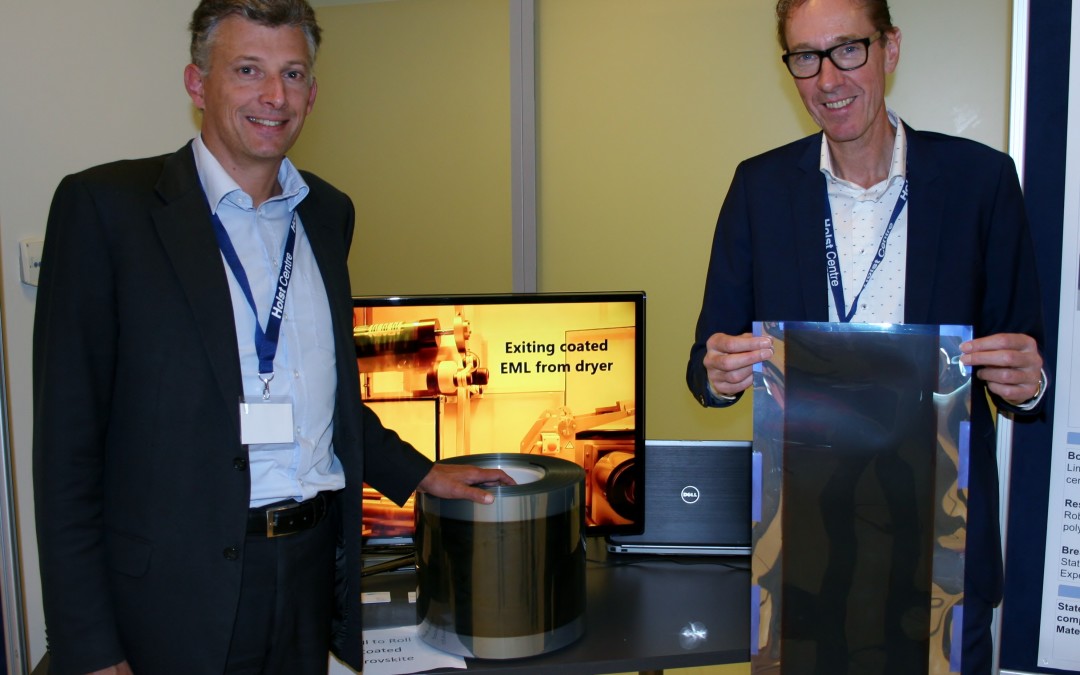Solliance, a Dutch-Belgian-German R&D partnership, has announced that it has achieved 12.6% efficiency in roll-to-roll (R2R) perovskite solar cells applicable to industrial production.
The breakthrough came via close collaboration with a number of perovskite and solar experts, including Dyesol, VDL Enabling Technologies Group and Bosch/Rexroth. The area of focus for this latest round of research was aimed at devising scalable and industrial processes for perovskite use, with Solliance confident that its new process could be suitable for the fabrication of large-area solar modules designed for BIPV applications.
The R2R process was carried out by Solliance’s dual R2R coating line, producing an in-line drying and annealing process executed at a linear speed of 5 m/min on a 30-cm PET/ITO foil under ambient conditions. The 12.6% efficiencies were registered on individual cells measuring 0.1 square cm, and Solliance stressed that the process was carried out using low cost materials and temperatures below 120 C – highlighting the mass adoption potential of the technique, the researchers claim.
At small-scale, laboratory conditions, perovskite efficiencies have reached 22.1%, but the challenge has always been to upscale that to a size suitable for the solar industry. Solliance’s achievement is a step along that path, and should help to expedite commercial adoption of the technology by enabling manufacturers to apply its industrial technique in their own manufacturing facilities.
“The demonstration of R2R processing at 5 m/min of perovskite layers for solar cells indicates that high/volume production, and hence with an expected low cost, will be possible in the future,” said Solliance program manager and professor of SMART materials at the Technical University of Delft, Pim Groen.
Popular content
The upstream companies involved in the production of the R2R coating line were a consortium led by VDL ETG, with the firm’s CEO Willem van der Leegte commenting that the combination of Solliance’s process know-how and the consortium’s high-tech equipment capabilities was pivotal in reaching these new efficiencies. Such knowledge sharing in Europe can “deliver very powerful results that potentially open up completely new business opportunities,” van der Leegte said.
For Australia’s Dyesol, the breakthrough was confirmation of its commitment to support Solliance and the wider perovskite research community on the path towards greater efficiencies and, eventually, commercialization.
“This pioneering work confirms that Dyesol and its partners retain a global leadership position in the industrialization of perovskite solar cell technology, and in particular its continuous R2R processing for flexible BIPV applications – a core element of its commercialization strategy.”
Perovskite solar cell technology is increasingly seen as the great white hope for solar energy harvesting due to its high power conversion efficiency and flexible, lightweight nature. It is still relatively fragile, but in terms of potential many in the industry see perovskite as a key ingredient in kickstarting BIPV applications, delivering performance, flexibility and desired aesthetics.
This content is protected by copyright and may not be reused. If you want to cooperate with us and would like to reuse some of our content, please contact: editors@pv-magazine.com.


Longevity measures are key here and article does dot address it at all. Perovskites degrade under both humoidiry (fixable w sealants),and under normal light exposure, which is not fixable. So, what is the product lifetime???!?
PV news provide the latest developments in both R &D and Commercial aspects in the field of Photovoltaics. Excellent compilation. This new achievement has far reaching implications, subject to long term performance under harsh environmental conditions.